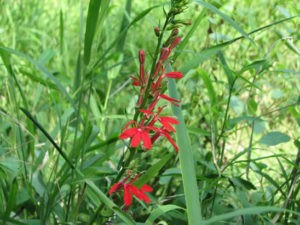"3-H Lawns": Healthy for Humans and Habitats
The Nature Center at Shaker Lakes has initiated a campaign to help individuals, families and communities create "3-H Lawns": Healthy for Humans and Habitats. Did you know that 67 million pounds of synthetic pesticides are used on U.S. lawns each year? This is more than the agricultural industry uses in the same period of time.
The Laudable Lawn & Home Habitat (LLHH) campaign was developed to counter the considerable chemical and resource-intensive yard blitz that can occur locally each spring. The LLHH campaign spawned from water quality studies of the Doan Brook, which indicated that fertilizers, pet wastes and some pesticides were the primary sources of pollution to the upper watershed of the heights. The program and educational opportunities have been initiated in partnership with the Doan Brook Watershed Partnership, the City of Shaker Heights, the City of Cleveland Heights, the City of Cleveland, the Holden Arboretum, the Cleveland Botanical Garden, the OSU Extension Service, the Cleveland Museum of Natural History, the Shaker Country Club and the Ohio Environmental Protection Agency.
In addition to improved water quality and human health, the LLHH will work to decrease needless expenses to household and community budgets. Between 35% to 85% of a community's natural resources are used at the household level with up to 75% of these resources wasted through inefficiency and lack of awareness. Additional benefits to creating a new backyard ethic include:
- Improved water, air & soil quality
- Decreased water & fuel consumption (On average, US homeowners pour 40-60% of their household water on to their yards)
- Decreased landfill material to be hauled and processed
- Decreased human, pet, and wildlife exposure to potential toxins (In 1989 the National Cancer Institute reported children develop leukemia six times more often when pesticides are used around their homes)
- Increased biodiversity
- Decreased municipal spending
- Increased demand for environmentally sustainable products and services
- Increased neighborhood and community interaction and fun
Five Components of a Laudable Lawn
1. No Low Mow: Mow high! A lawn should be moved with a sharpened mower to a preferred height of three inches. Allowing the grass to grow tall encourages the roots to grow strong and deep, resulting in healthier grass that can withstand dry periods and other stresses. This is the most important thing you can do to improve the health of your lawn!
2. Water sparingly: Here in Northeast Ohio, we usually get enough rain during the summer to eliminate the need for watering the lawn. Grasses naturally slow their growth during the hot, dry summer months. During the dormant period, brown patches of lawn are not dead; they're just resting! You can check to see if your lawn needs water by walking across it. If footprints linger for several hours, your grass is severely dehydrated and needs water. Remember, between you and Mother Nature – never water more than one inch per week.
3. Forsake the Rake: Fertilize by leaving grass clippings on the lawn. The grass clippings that remain after mowing contain the three main fertilizer ingredients: nitrogen, phosphorus and potassium. Clippings decompose in 1-2 days (thanks to earthworms and soil microorganisms) and do not contribute to thatch accumulation. Important fact: during the growing season, grass clippings account for 50% of the waste sent to landfills around the Great Lakes.
4. Test Your Soil: Grass grows best in 4-6 inches of well drained topsoil with plenty of organic matter. Soil pH should be between 6.5 and 7.0. The best place to inquire about soil sampling is your local Soil and Water Conservation District or the Ohio State University Cooperative Extension Service. Remember that grass can't grow successfully everywhere. Just like every other plant, it needs certain physical conditions and soil components to survive. The most important conditions for successful grass growth include good soil, plenty of sun and adequate moisture.
5. Go Native: Plant native trees, shrubs, grasses and wild flowers that are already well adapted to the Northeast Ohio environment. Native species require less fertilizer, water, and maintenance. Birds and wildlife will benefit from a diverse menu of berries and weeds not found in a backyard comprised of a grass monoculture, Corporations, too, can decrease lawn size, save money and become models of sound ecology. Landscape fragmentation and loss of biodiversity have become major environmental issues. Moving away from mono-cultures like lawns of only grass is one way to increase the healthy function of the ecosystem upon which we all depend.

